Muscle Identification
1/49
There's no tags or description
Looks like no tags are added yet.
Name | Mastery | Learn | Test | Matching | Spaced |
|---|
No study sessions yet.
50 Terms
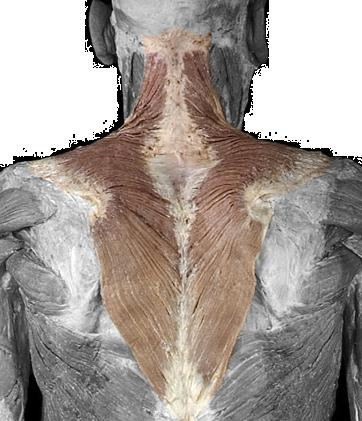
Identify
Trapezius
Origin: Skull and thoracic vertebrae
Insertion: Clavicle and scapula (acromion and spine of scapula)
Action: Elevation, depression and adduction of scapula.
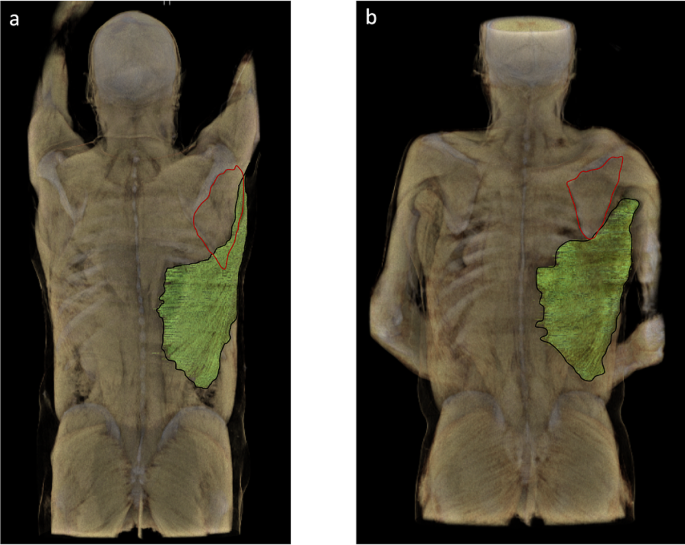
Identify
Latissimus Dorsi
Origin: Spinous processes of inferior thoracic and all lumbar vertebrae, ribs 8-12 and lumbodorsal fascia.
Insertion: Floor of intertubercular groove of humerus.
Action: Extending, adducting and internally rotating arm at shoulder joint. Pull inferior angle of scapula in various directions.
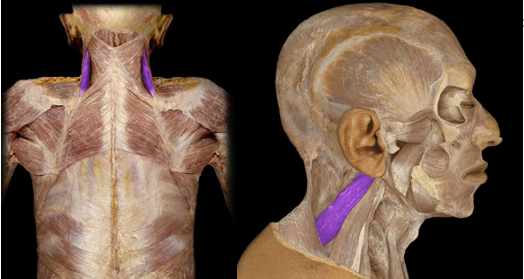
Identify
Levator Scapulae
Origin: Posterior tubercle of transverse processes of C1-C4
Insertion: Superior angle of medial border of scapula.
Function: Lifts the scapula
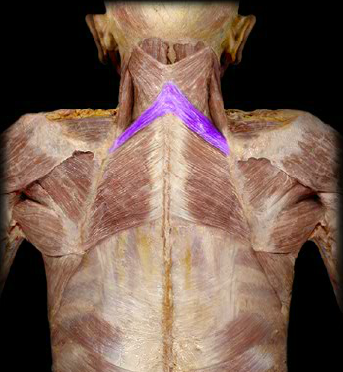
Identify
Rhomboid minor
Origin: Spinous processes of C7-T1 and nuchal ligament
Insertion: Medial border of scapula
Action: Retract, elevate and rotate scapula
Identify
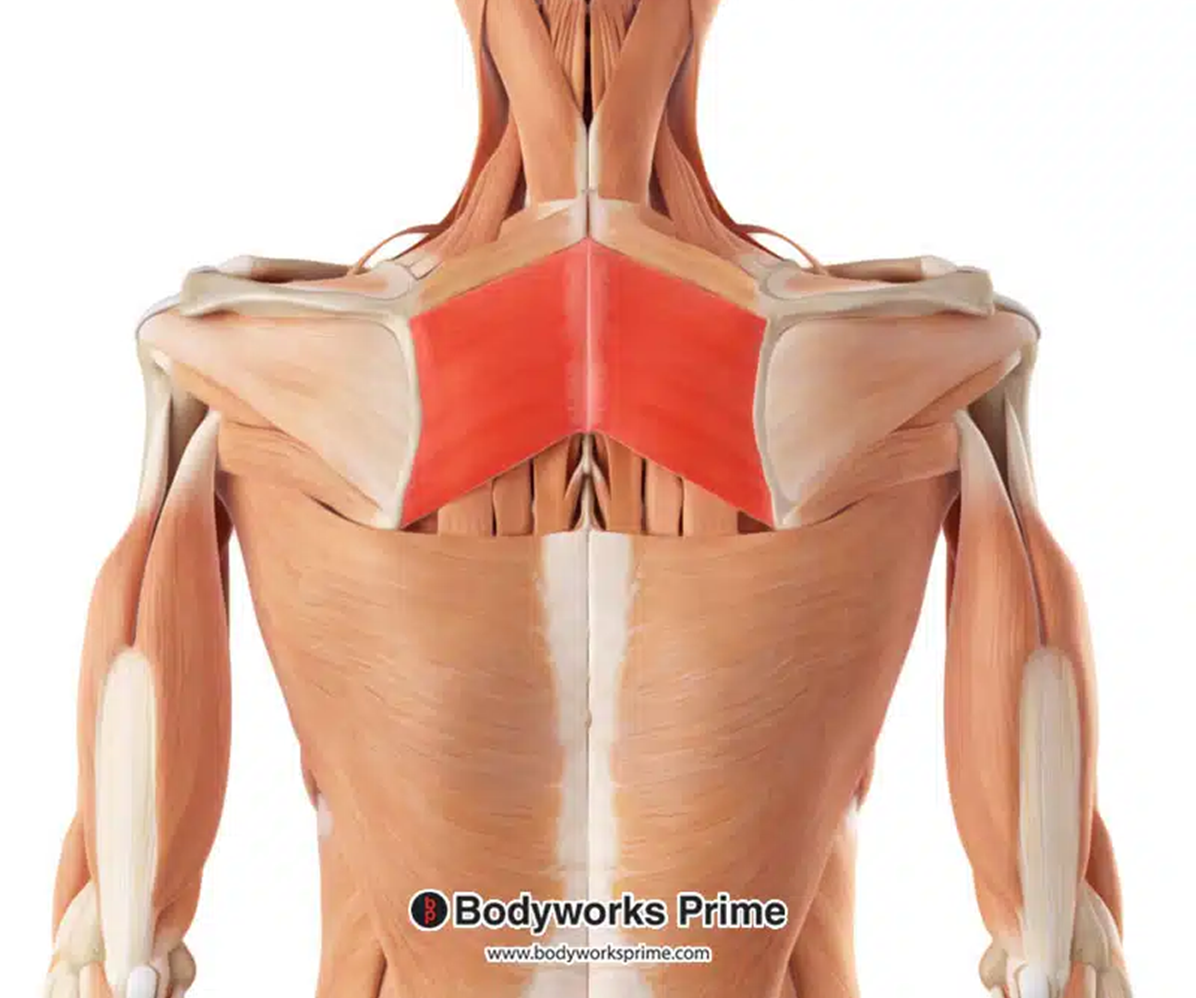
Rhomboid major
Origin: Spinous processes of T2-T5
Insertion: Medial border of scapula
Action: Retract, elevate and rotate scapula
Teres Major
Origin: Inferior angle of scapula
Insertion: Medial lip of intertubecular groove of humerus.
Action: Brings humerus towards scapula (adductor).
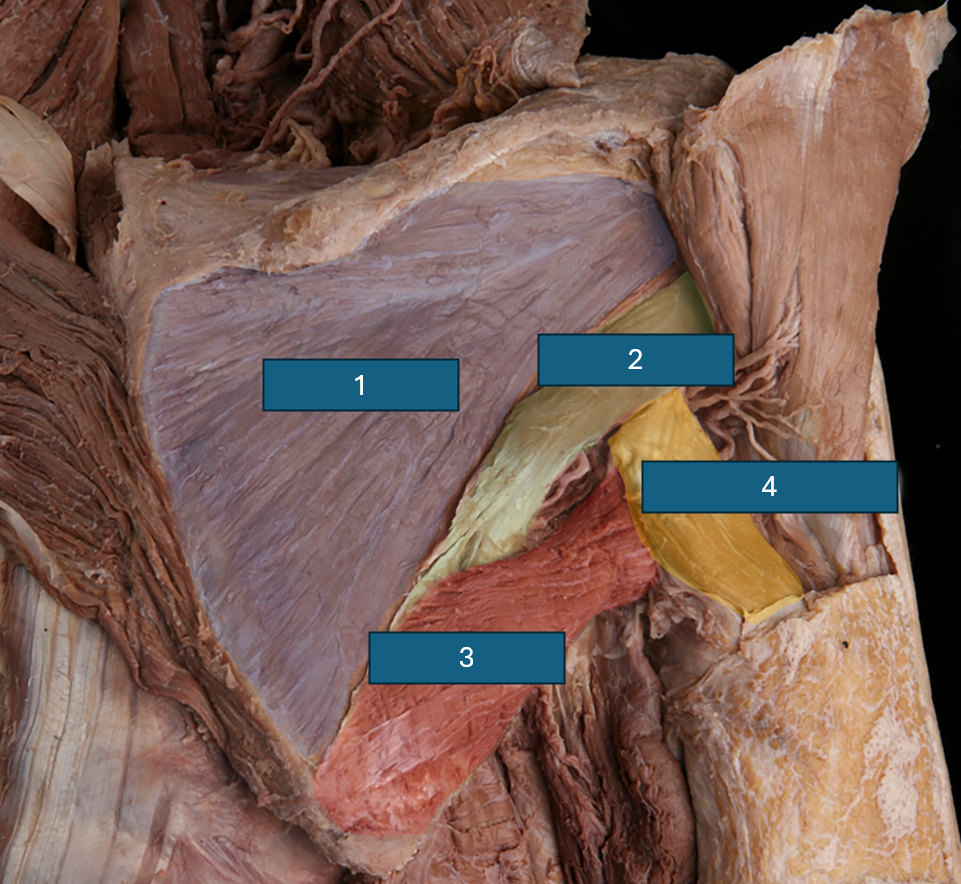
1
Infraspinatus
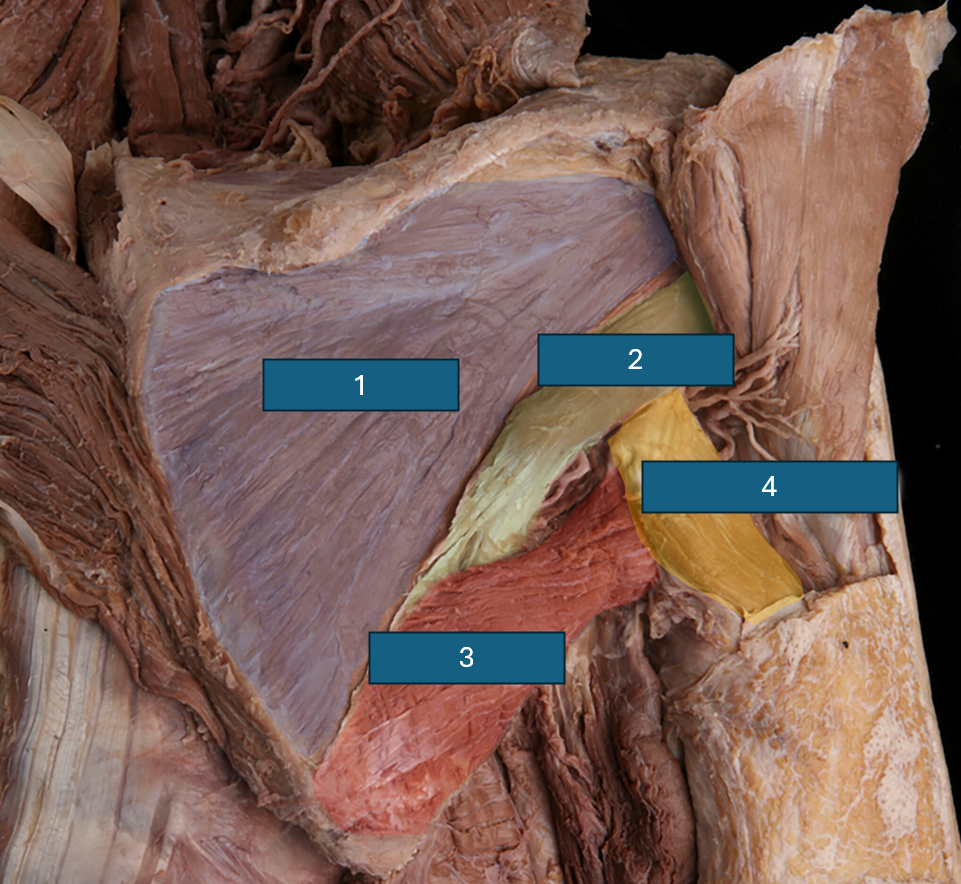
2
Teres minor
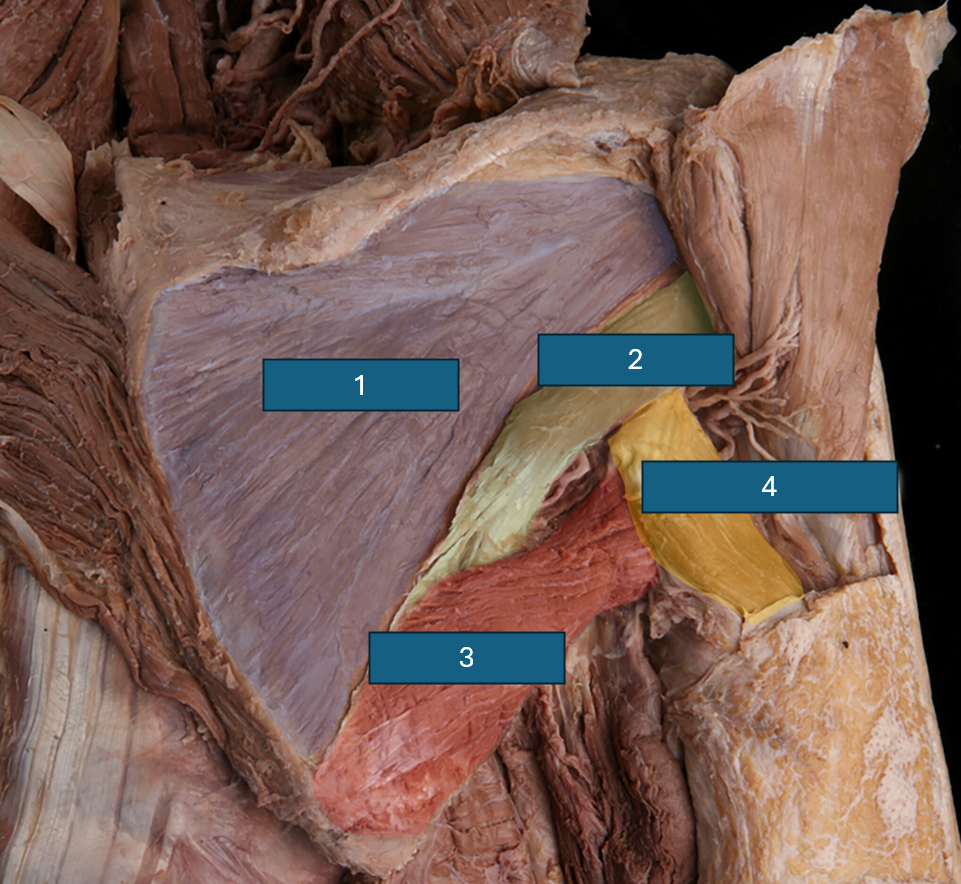
3
Teres major
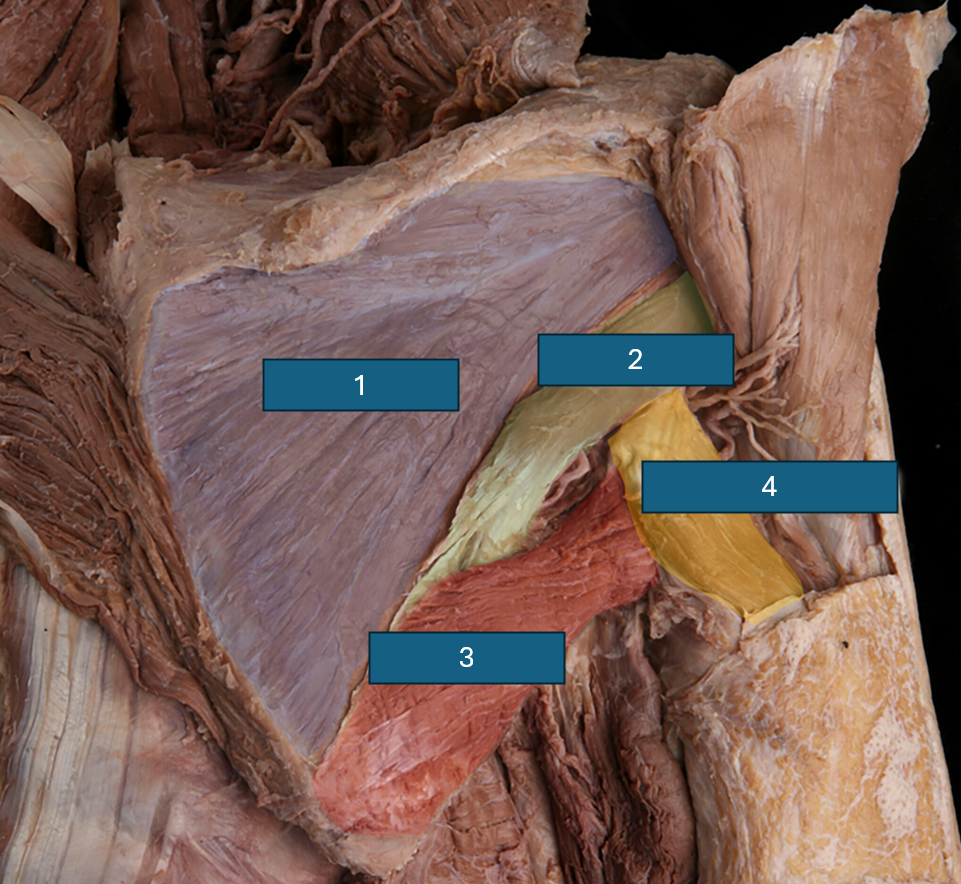
4
Triceps long head
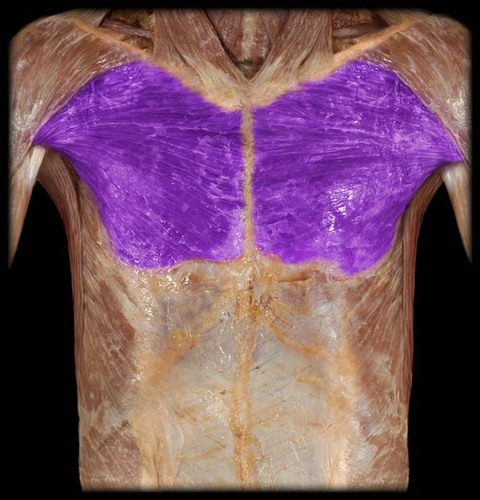
Identify
Pectoralis major
Origin: Body of sternum, costocartilages 2-6 and inferomedial portion of clavicle.
Insertion: Greater tubercle of humerus and lateral lip of intertbecular groove of humerus.
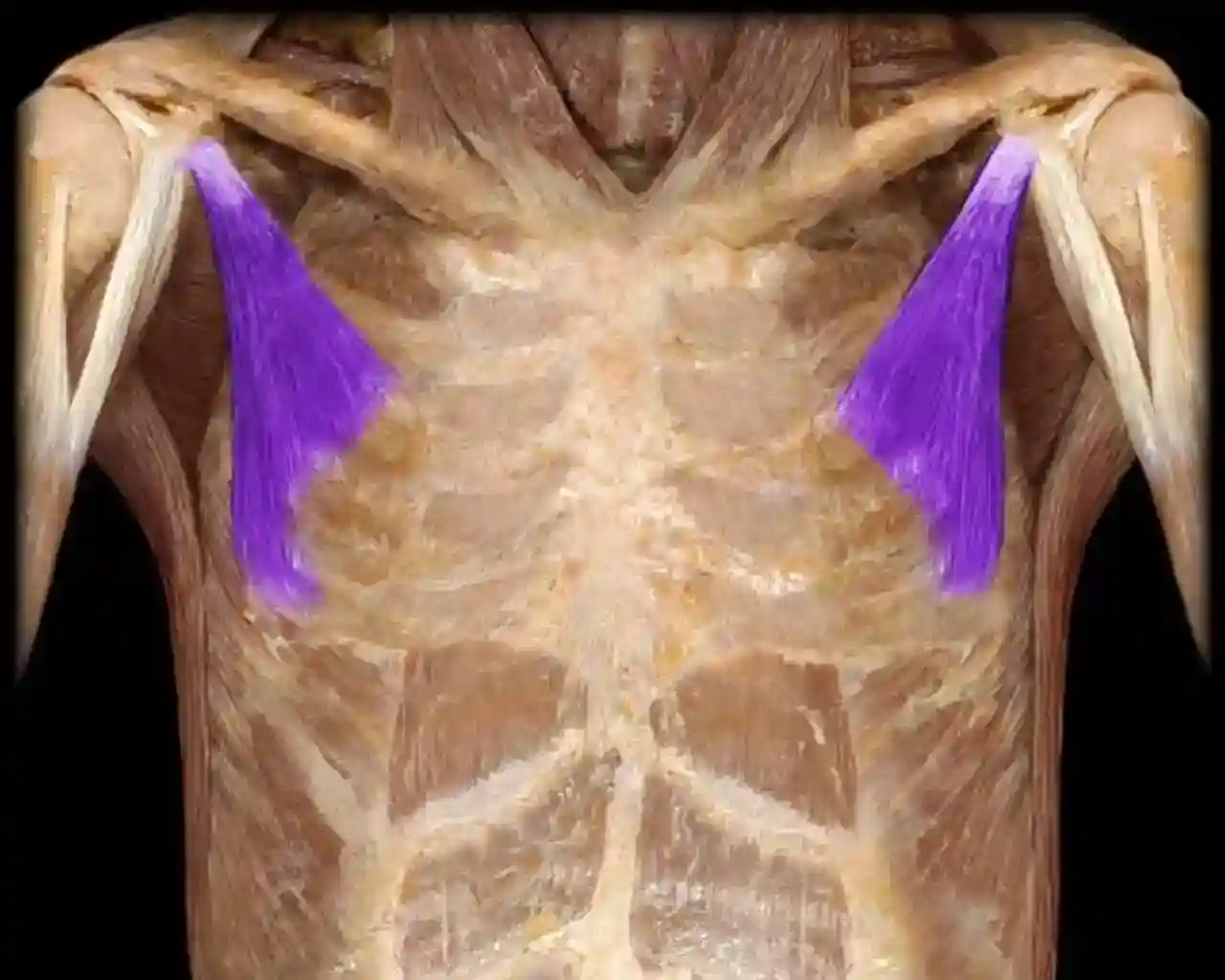
Identify
Pectoralis minor
Origin: Anterosuperior surfaces of ribs 3-5
Insertion: Coracoid processes of scapula.
Action: Pulls scapula to front and downwards (protraction and depression).
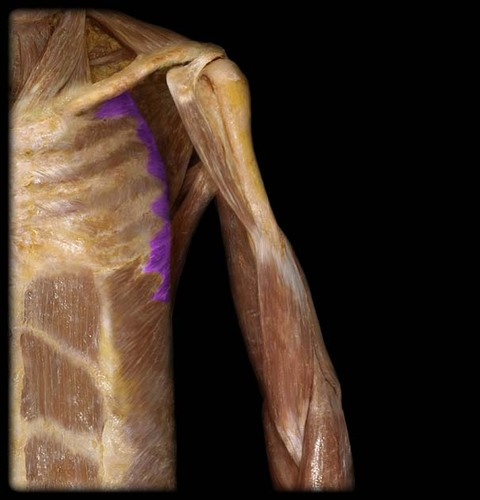
Identify
Serratus anterior
Origin: Anterosuperior margins of ribs 1-8/9
Insertion: Medial border of scapula.
Action: Pulls medial border of scapula in. Abduction and protraction of the scapula.
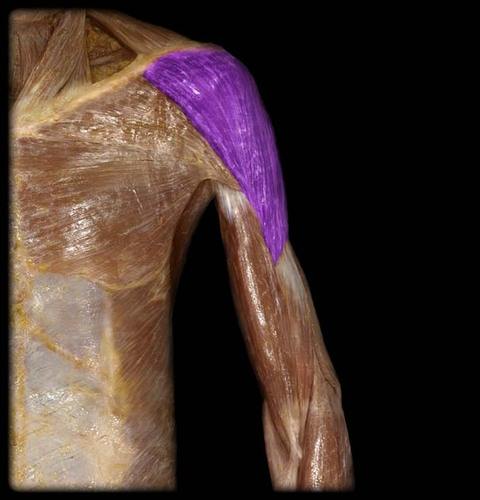
Identify
Deltoid
Origin: Lateral clavicle, acromion and spine of scapula
Insertion: Lateral humerus (deltoid tuberosity).
Action: Front part - flexion Back part - extension Middle part - abduction
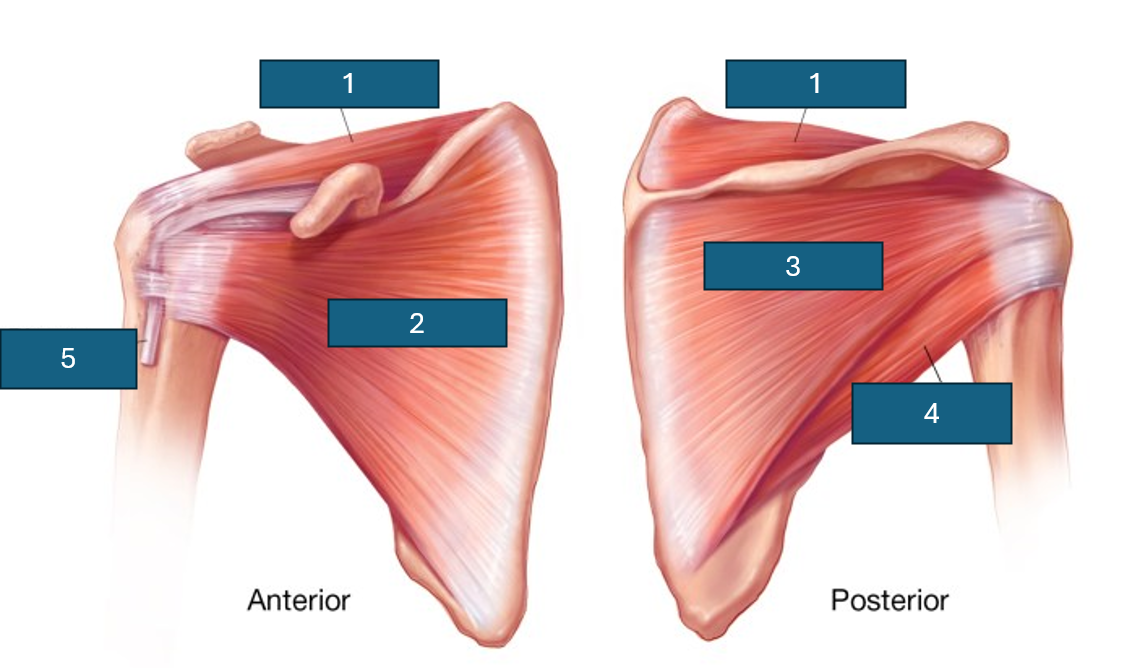
1
Supraspinatus
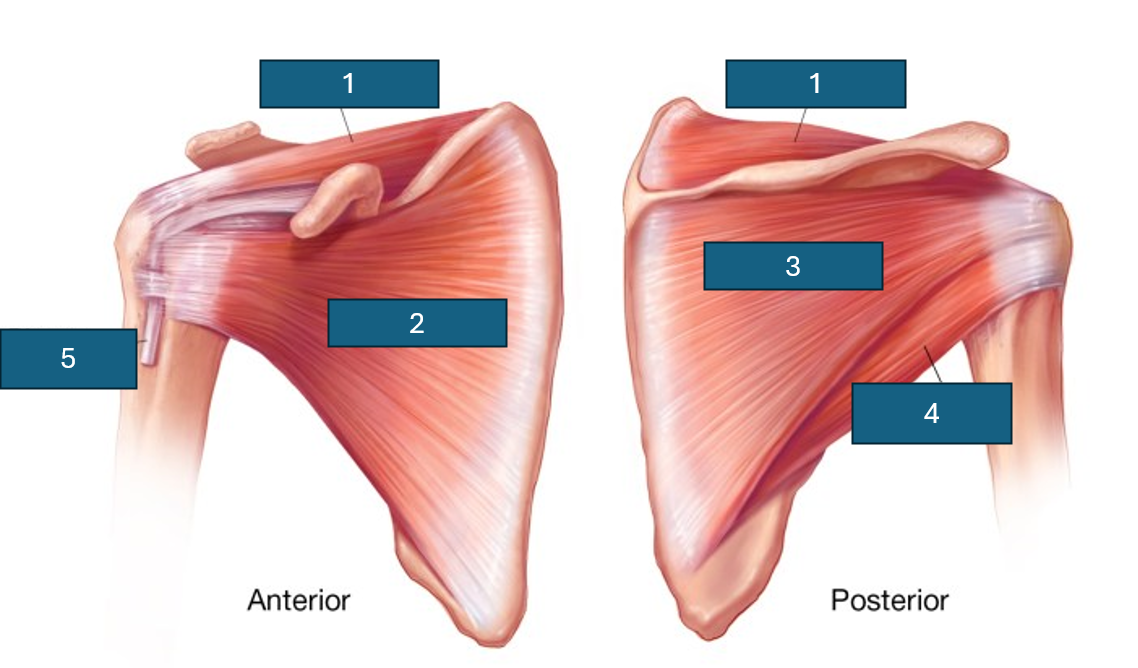
2
Subscapularis
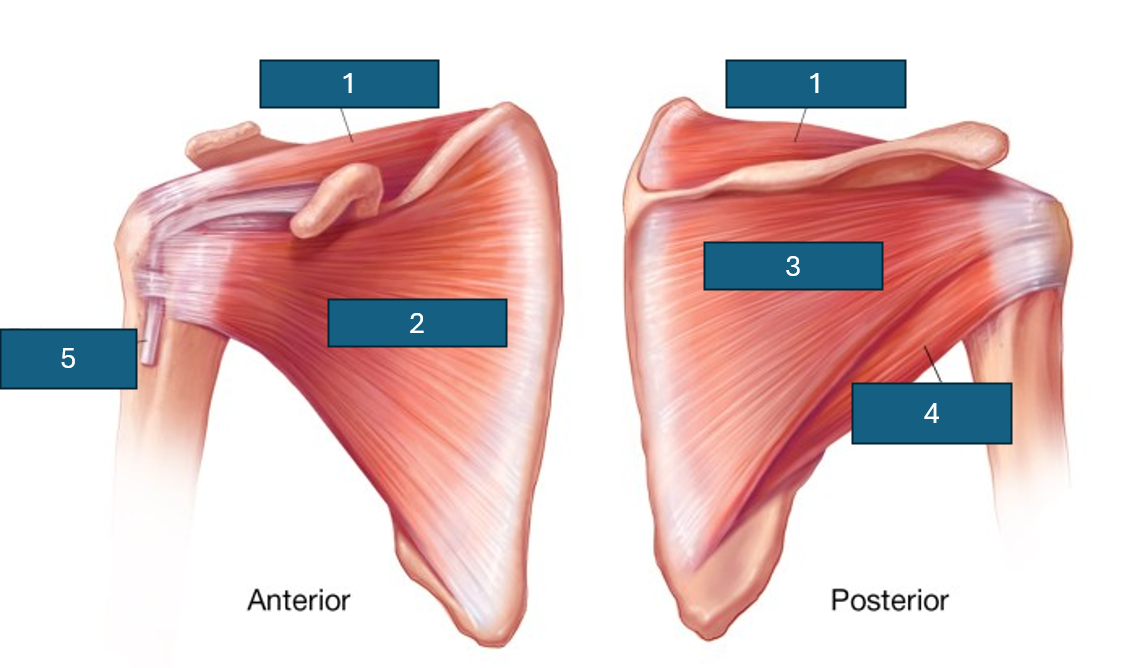
3
Infraspinatus
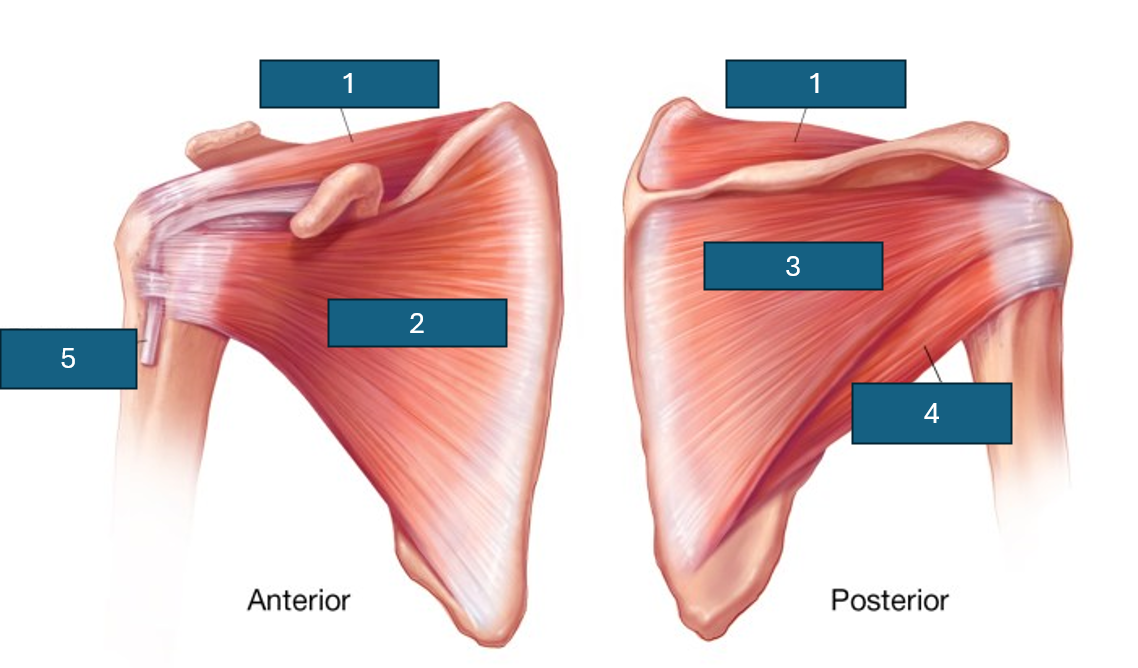
4
Teres minor
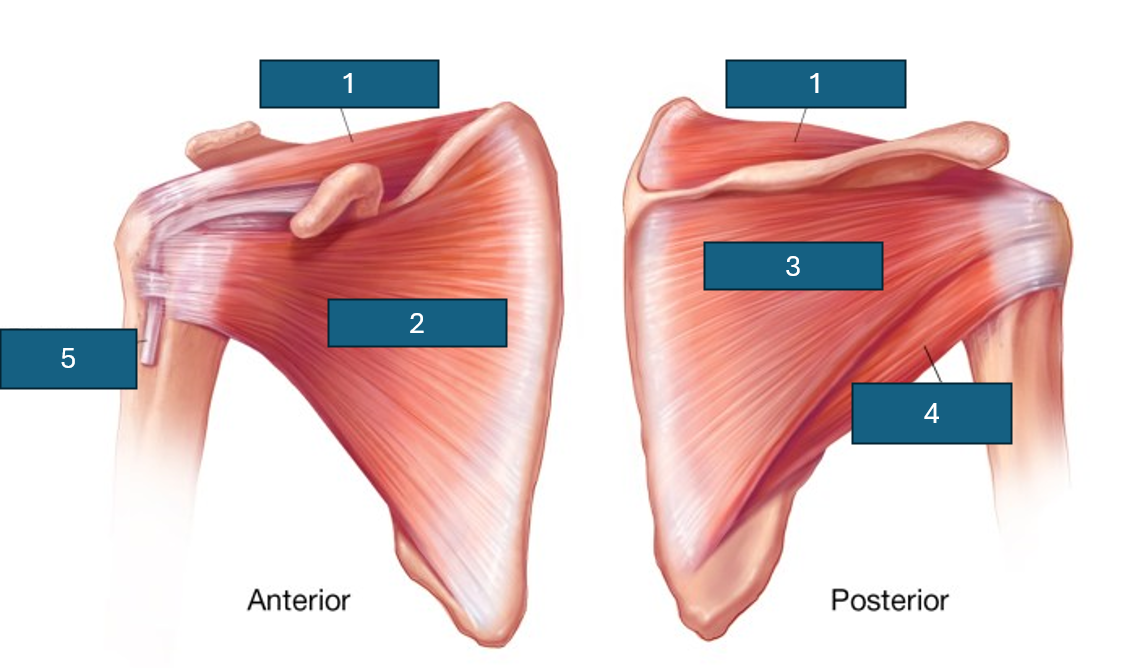
5
Biceps tendon
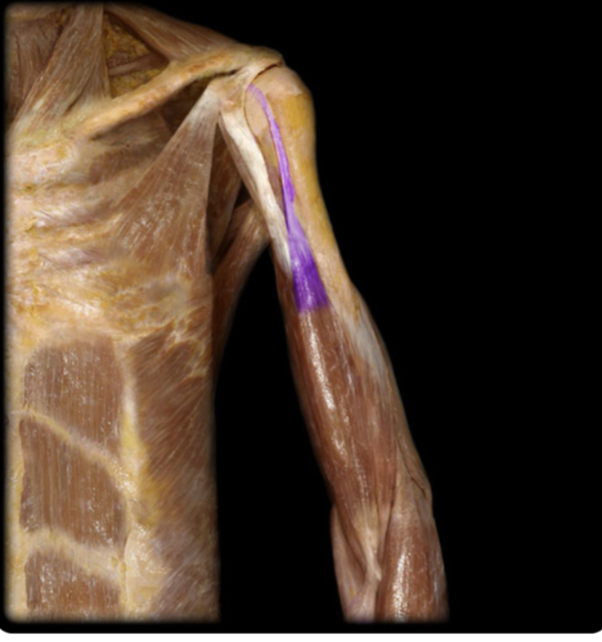
Identify
Biceps Brachii long head
Origin: Supraglenoid tubercle
Insertion: radial tuberosity.
Action: Flexion of shoulder and elbow and supination.
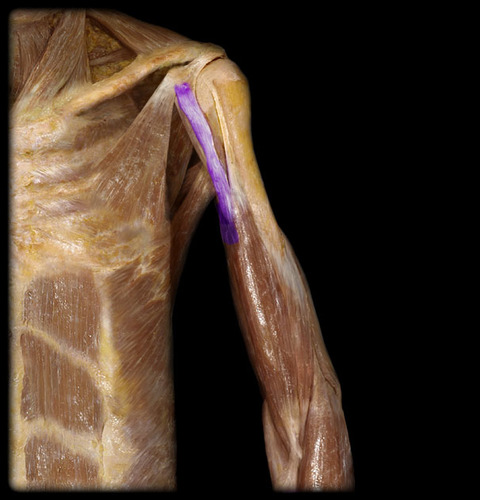
Identify
Biceps Brachii short head
Origin: coracoid process
Insertion: Radial tuberosity
Action: Flexes elbow and shoulder and supinates arm.
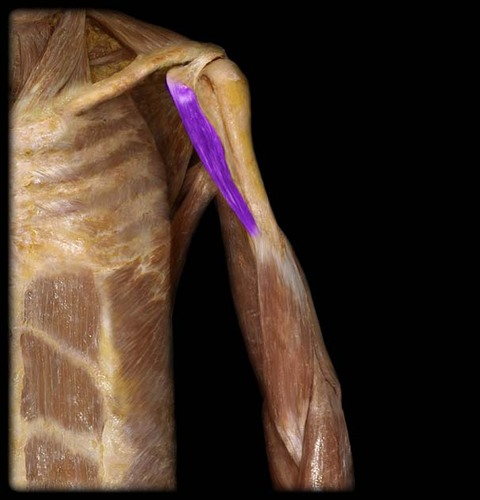
Identify
Coracobrachialis
Origin: Coracoid process of scapula
Insertion: Shaft of humerus
Action: Flex and adduct arm at shoulder joint
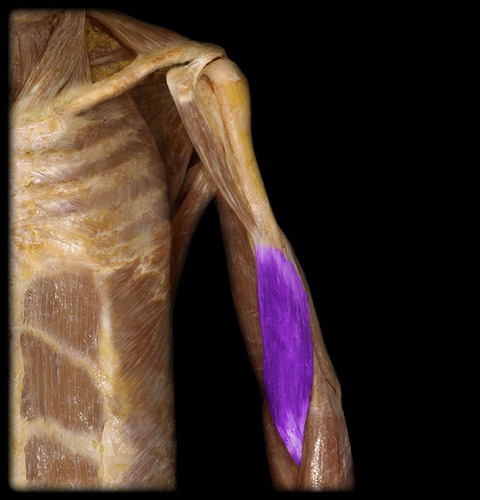
Identify
Brachialis
Origin: Shaft of humerus
Insertion: Coronoid process of the ulna
Action: Flexion of elbow
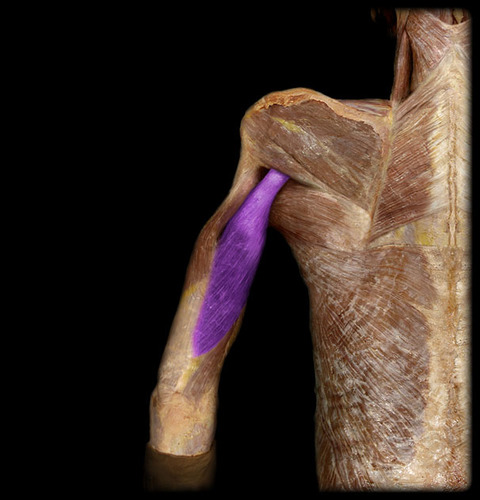
Identify
Triceps Brachii long head
Origin: Scapula (infraglenoid tubercle)
Insertion: Olecranon process
Function: Extension of humerus and adduction.
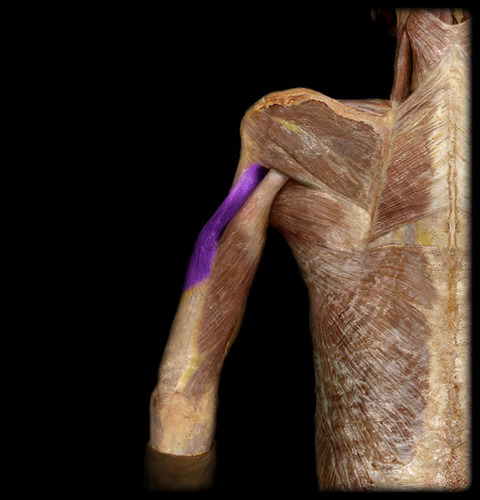
Identify
Triceps brachii lateral head
Origin: Shaft of humerus
Insertion: olecranon process of ulna
Action: Extends forearm.
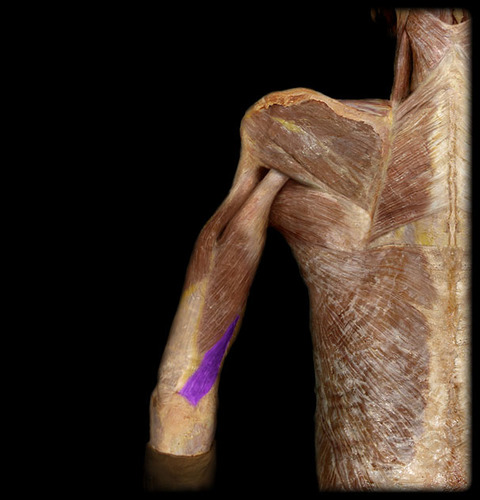
Identify
Triceps brachii medial head
Shaft of humerus
Olecranon process of ulna
Extends forearm
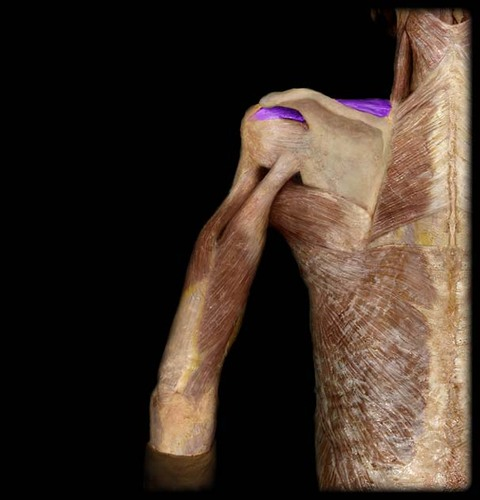
Identify
Supraspinatus
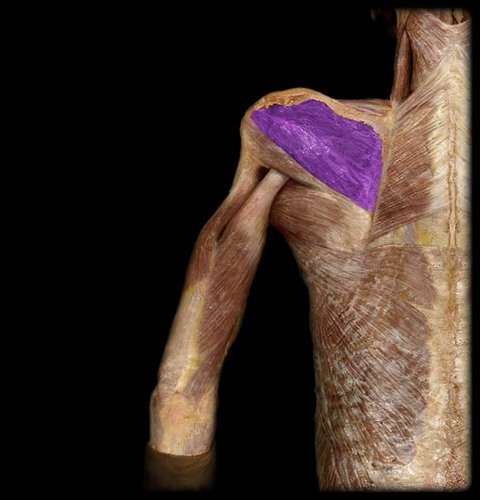
Identify
Infraspinatus
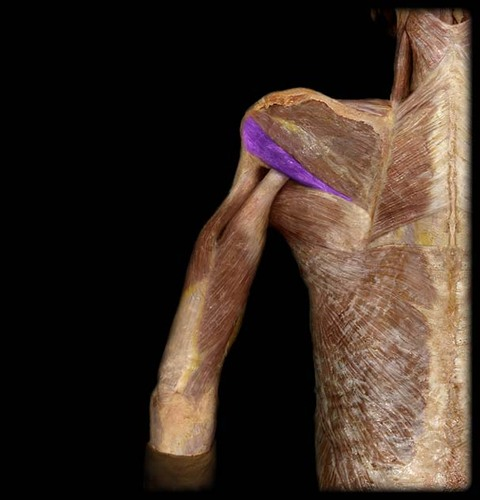
Identify
Teres minor
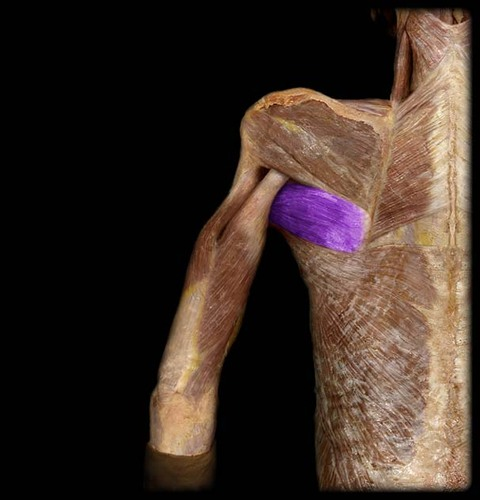
Identify
Teres major
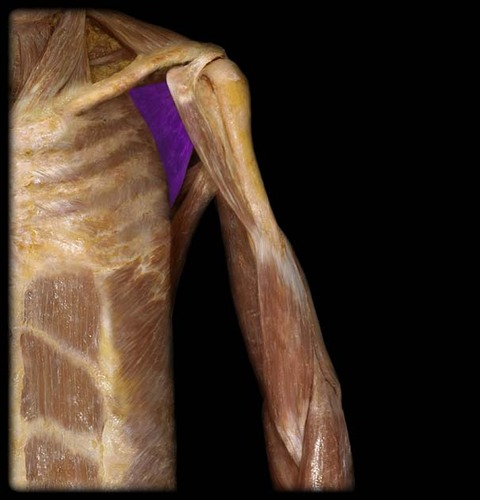
Identify
Subscapularis
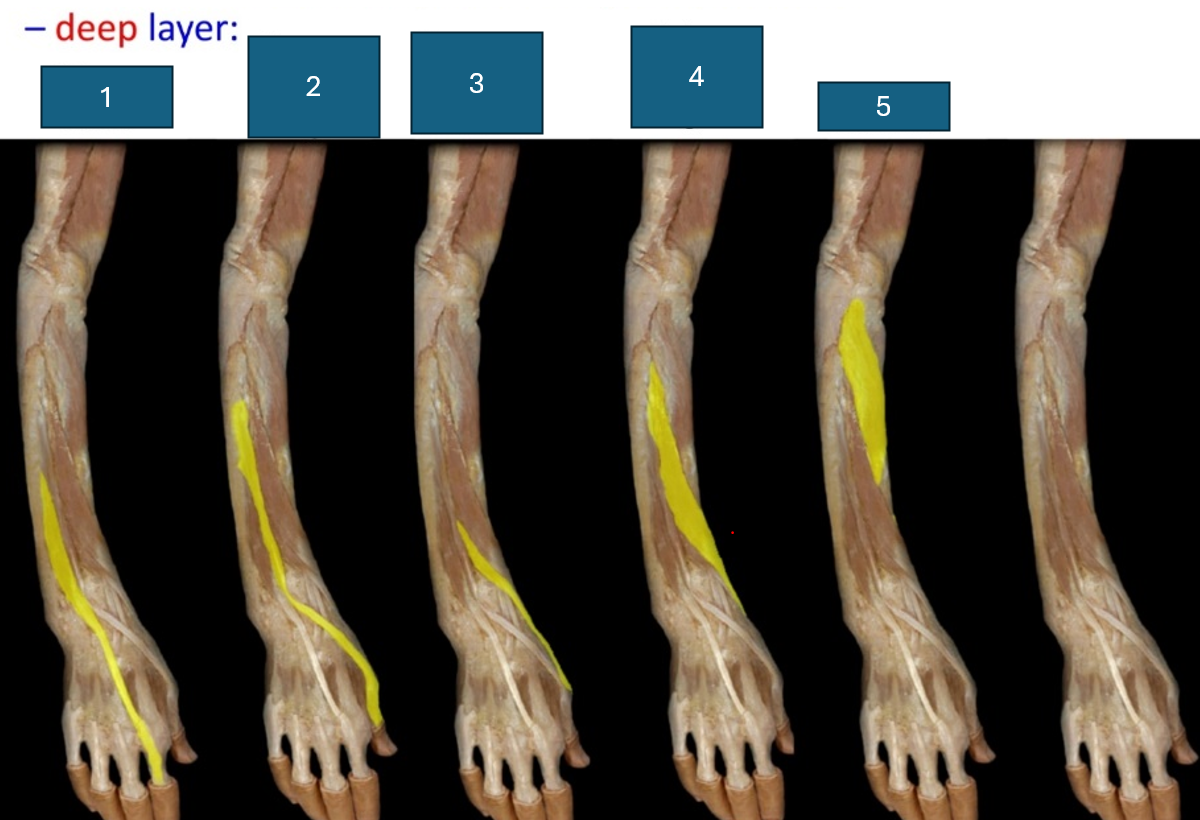
1
Extensor indicis
Origin: Posterior surface of distal ulna and interosseous membrane.
Insertion: Extensor expansion of index fingers
Action: Extend index finger
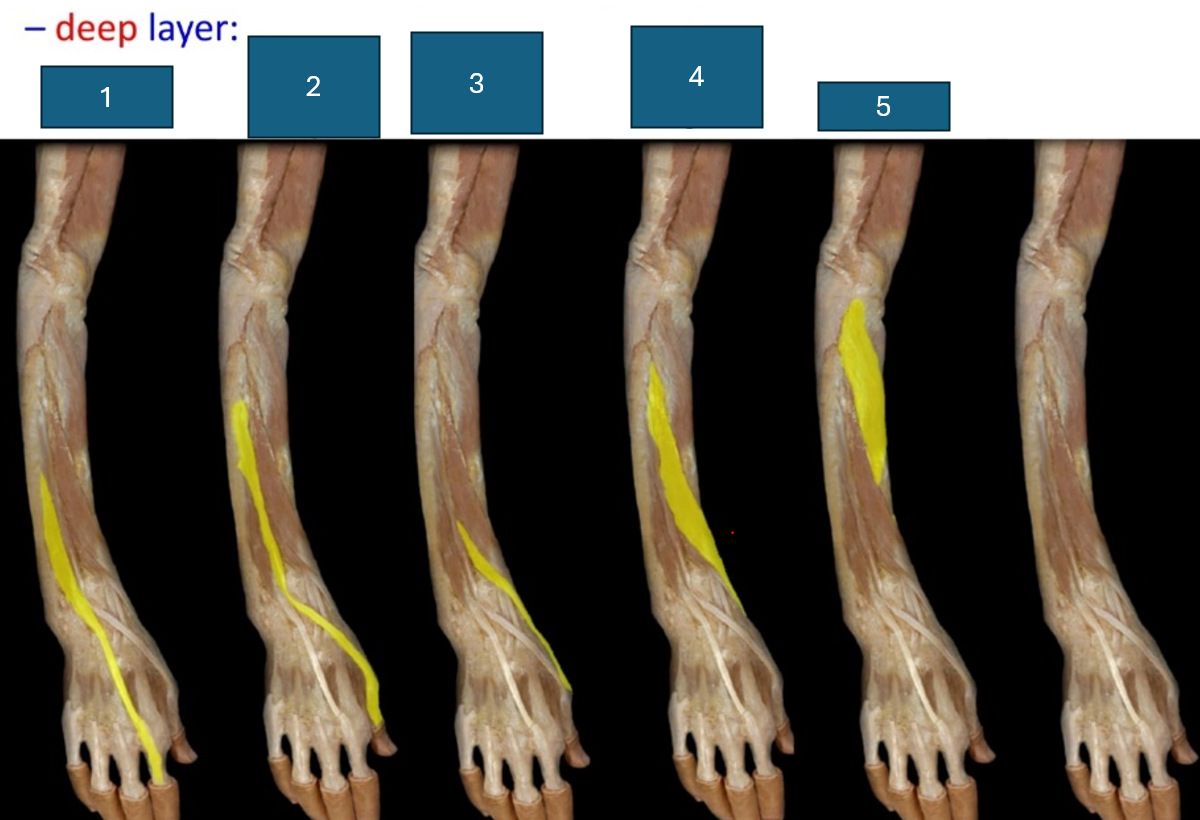
2
Extensor Pollicis Longus
Origin: Dorsal shaft of radius/ulna and interosseous membrane.
Insertion: Base of distal phalanx thumb
Action: Extends thumb
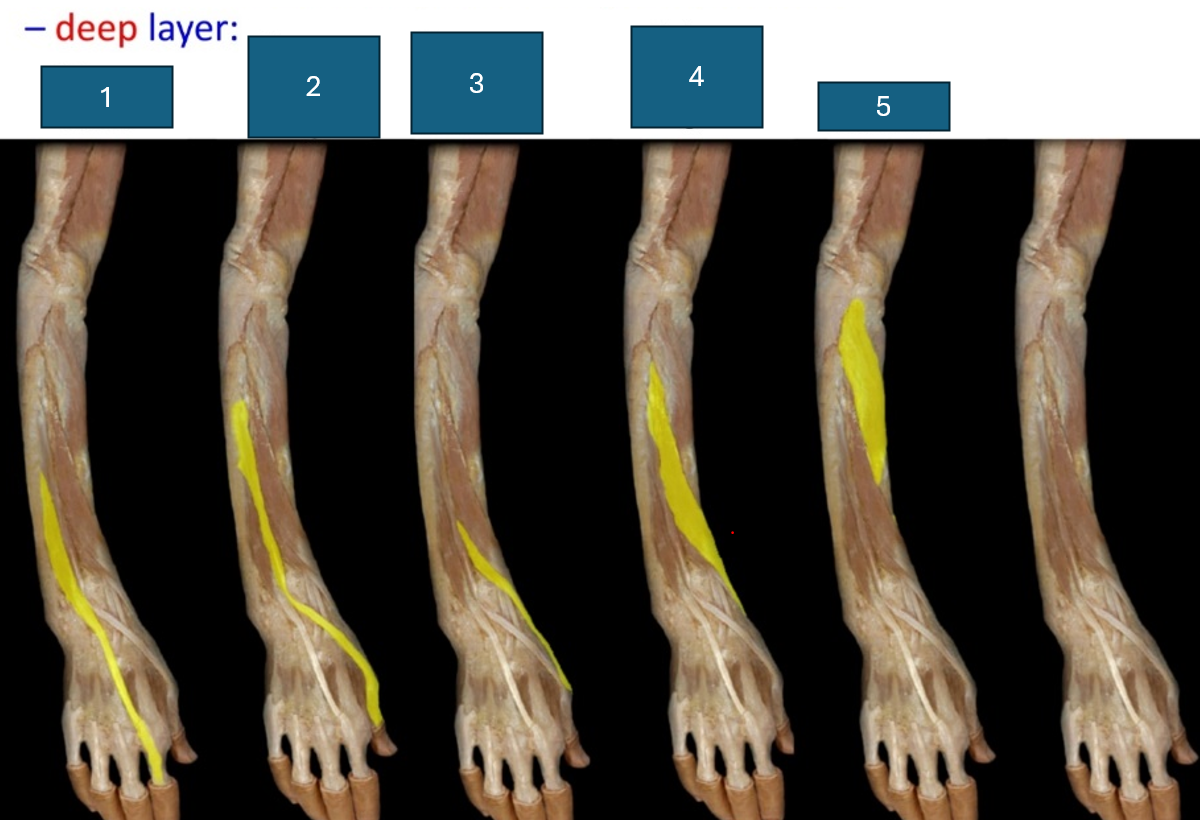
3
Extensor Pollicis Brevis
Origin: Dorsal shaft of radius/ulna and interosseous membrane.
Insertion: Base of proximal phalanx thumb
Action: Extends thumb
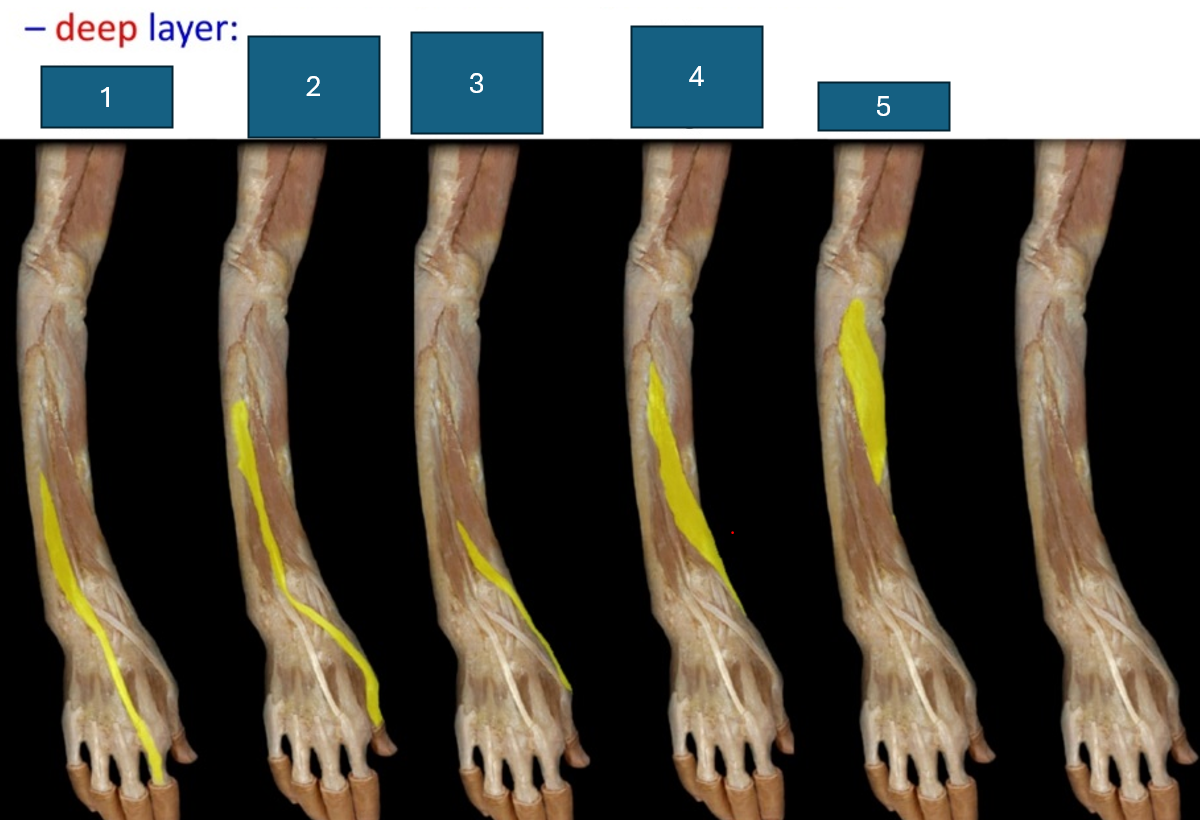
4
Abductor Pollicis Longus
Origin: Posterior shaft of radius and ulna and interosseous membrane
Insertion: Base of first metacarpal and trapezium.
Action: Abducts thumb
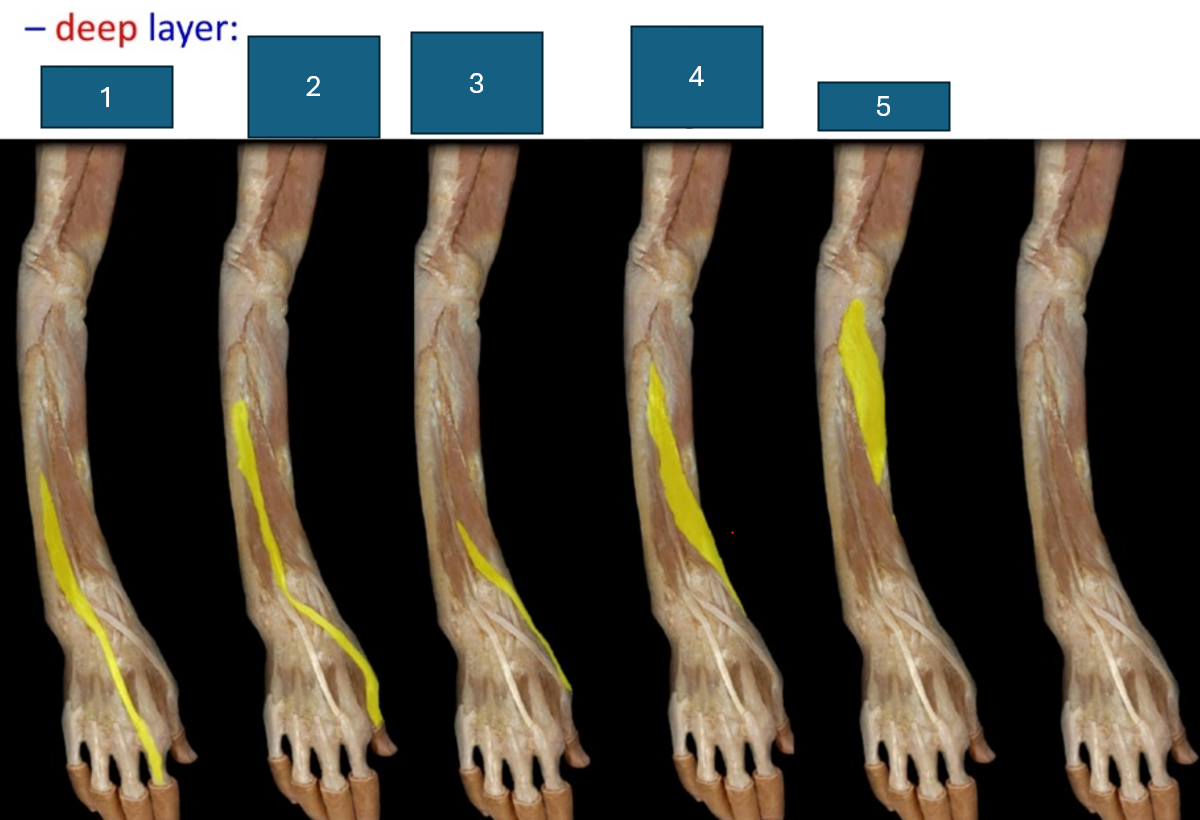
5
Supinator
Origin: Lateral epicondyle of humerus and proximal ulna
Insertion: Proximal Radius
Action: Supination of forearm/hand
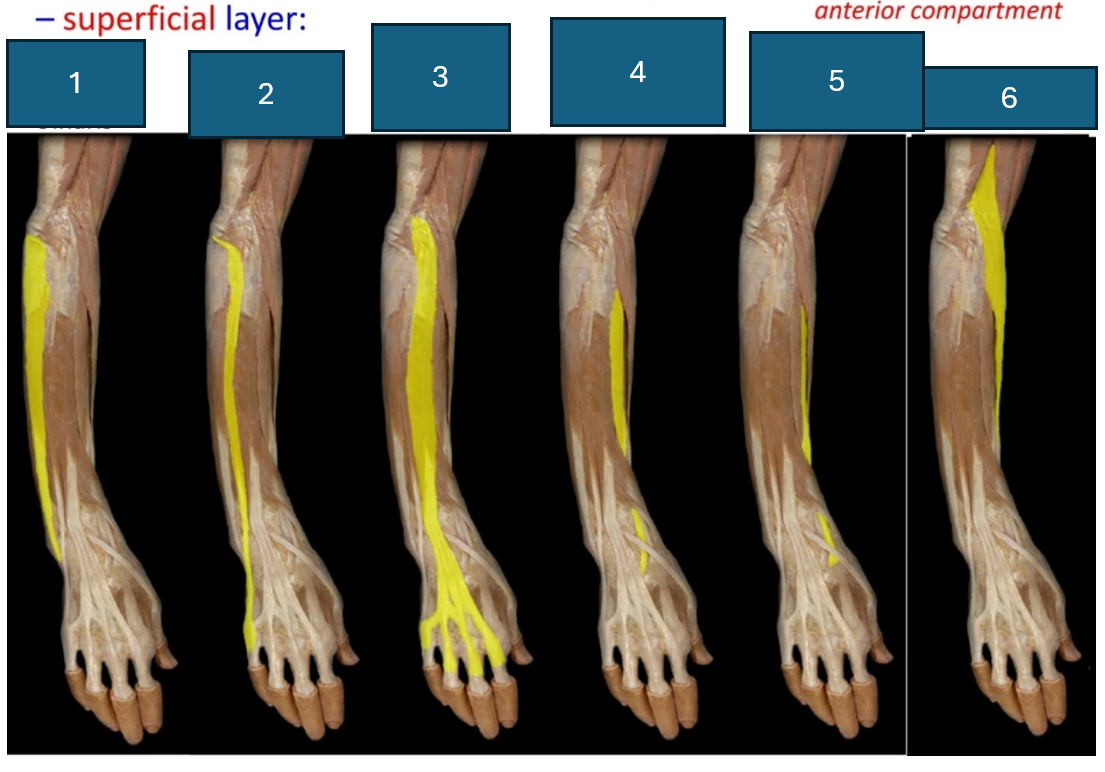
1
Extensor Carpi Ulnaris
Origin: Lateral epicondyle of humerus (common)
Insertion: Ulnar dorsal hand (base of 5th metacarpal)
Action: Extends wrist on ulnar side.
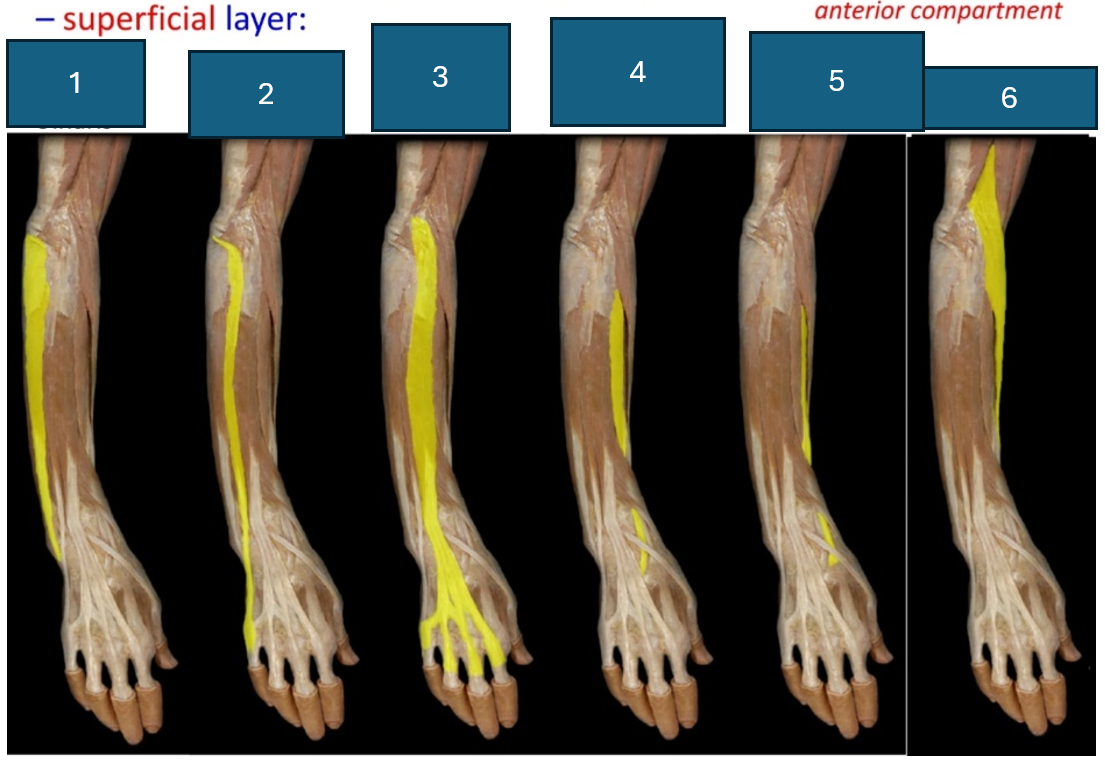
2
Extensor digiti minimi
Origin: Lateral epicondyle of humerus
Insertion: Proximal phalanx of little finger
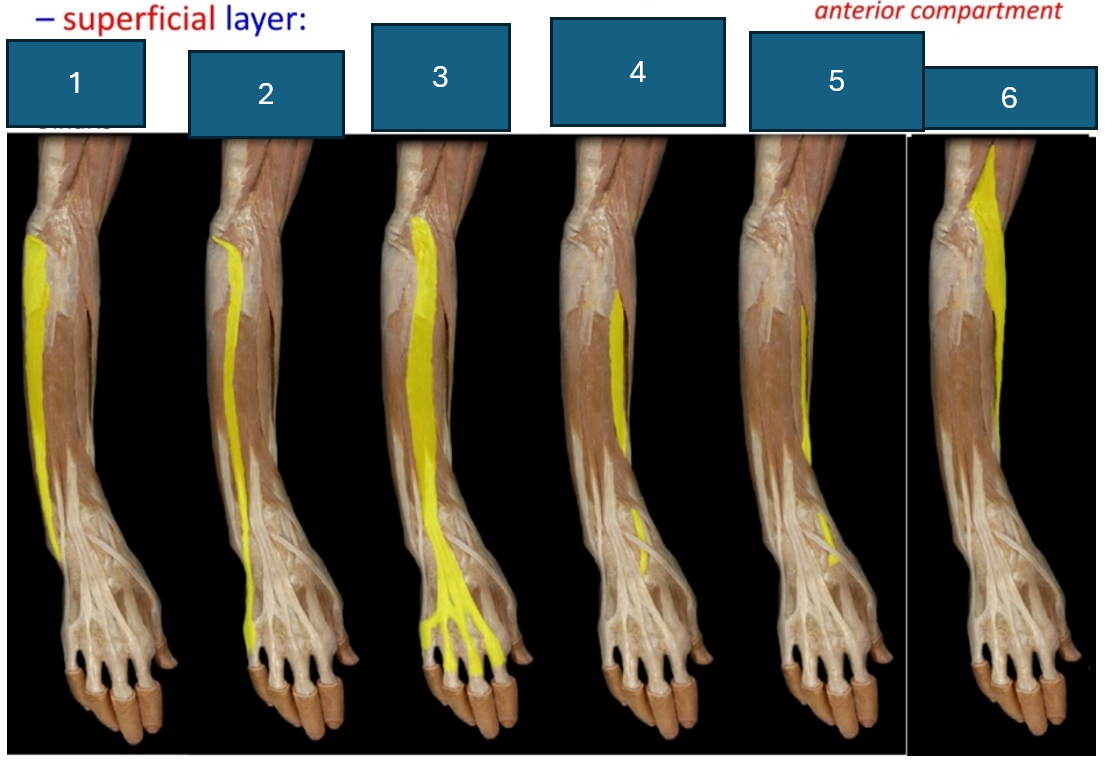
3
Extensor digitorum
Origin: Lateral epicondyle of humerus
Insertion: Distal phalanges of digits 2-5
Action: Extend the four medial fingers at metacarpophalangeal and interphalangeal joints
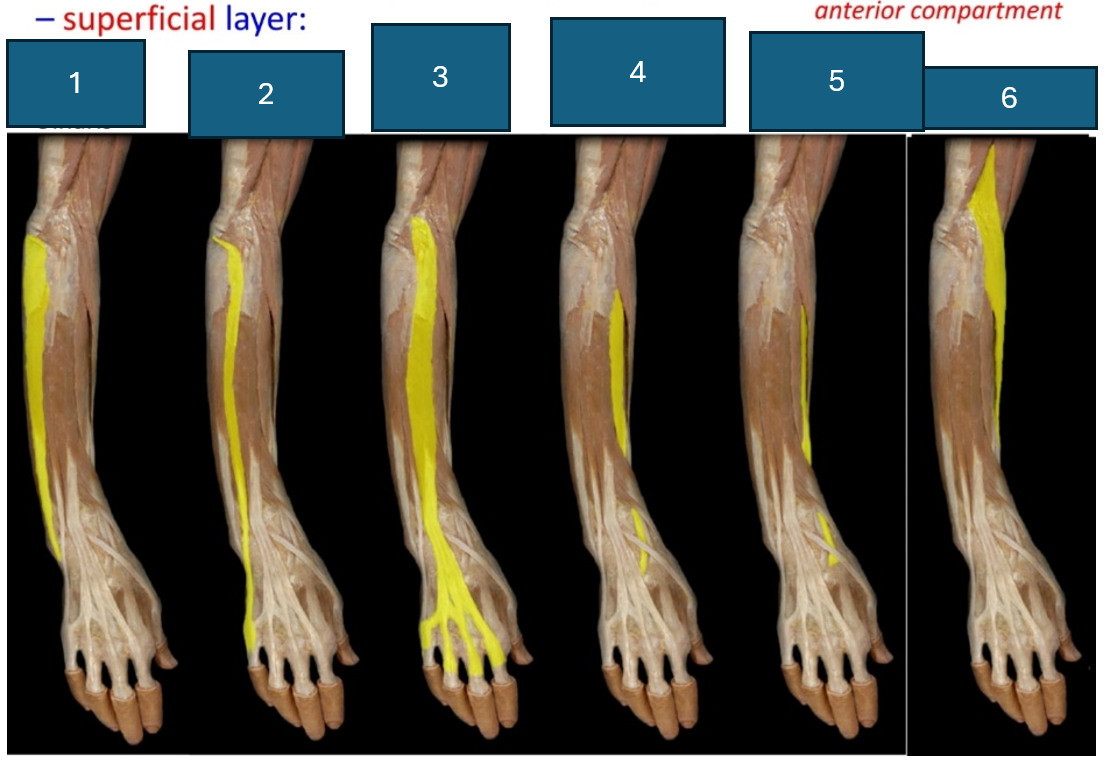
4
Extensor Carpi Radialis Brevis
Origin: Lateral epicondyle of humerus
Insertion: Base of 3rd metacarpal
Action: Extension and abduction of wrist
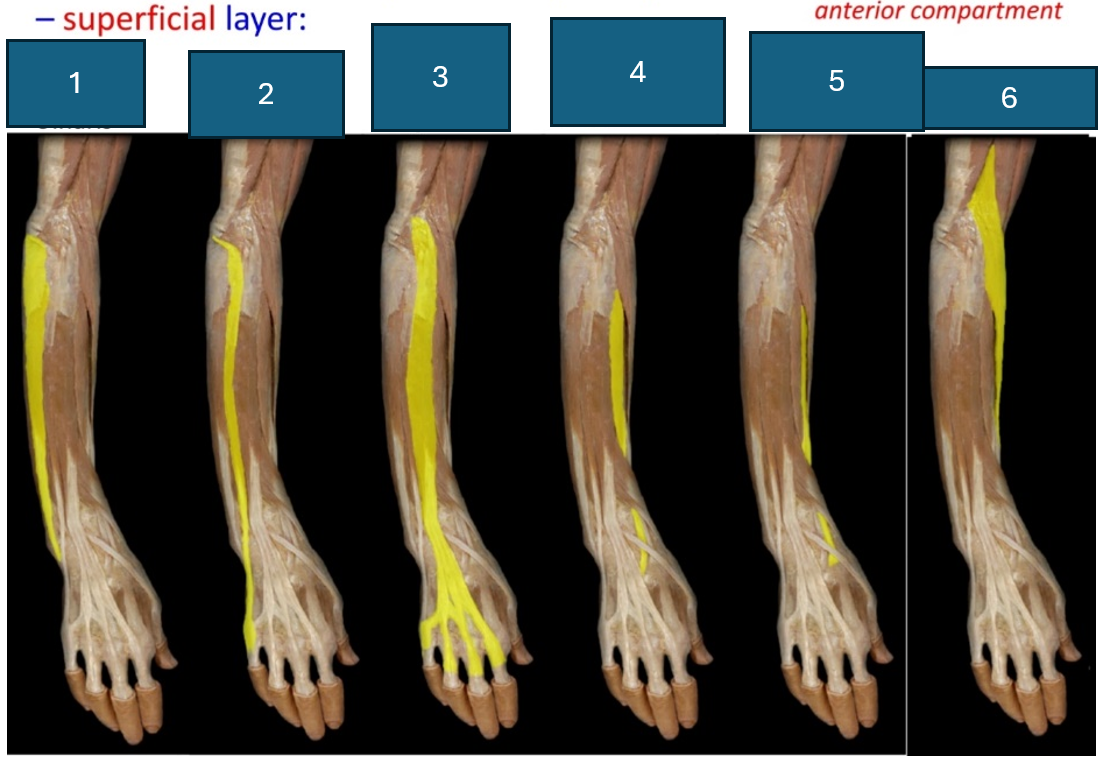
5
Extensor Carpi Radialis Longus
Origin: Lateral supracondylar ridge
Insertion: Base of 2nd metacarpal.
Action: Extend and abduct
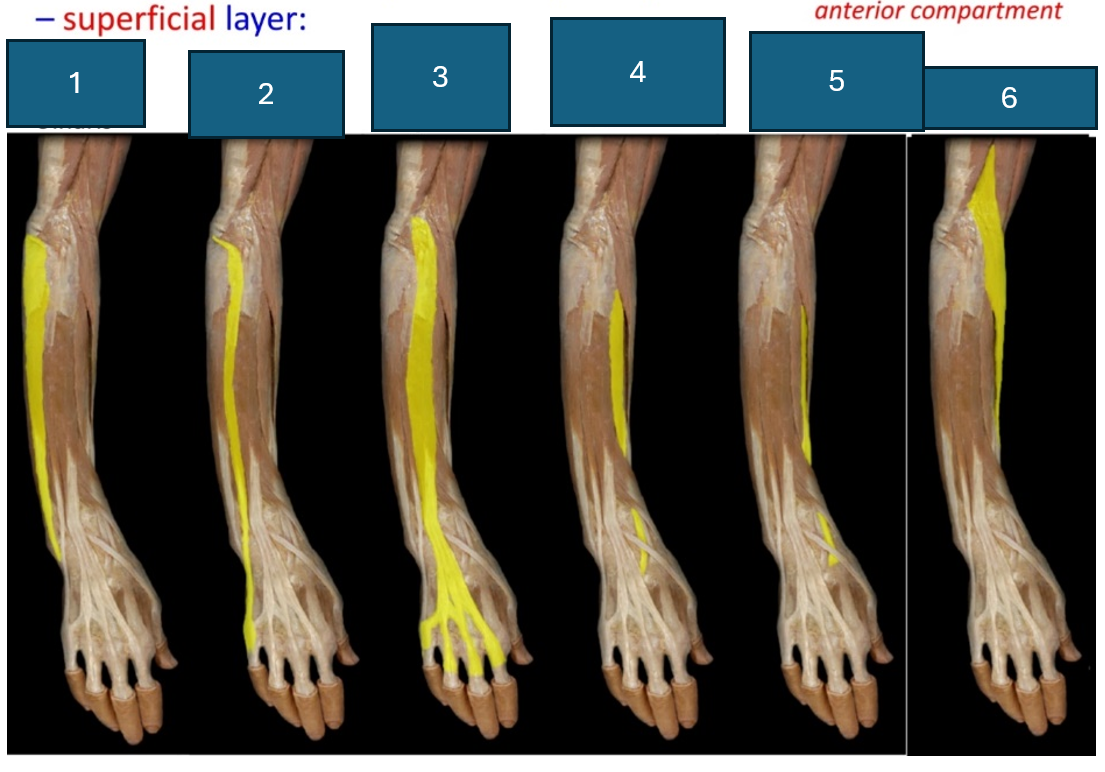
6
Brachioradialis
Origin: Humerus (above lateral epicondyle)
Insertion: Base of styloid process of radius (DOESN’T CROSS WRIST)
Action: Flexor of the elbow (however is part of the extensor compartment)
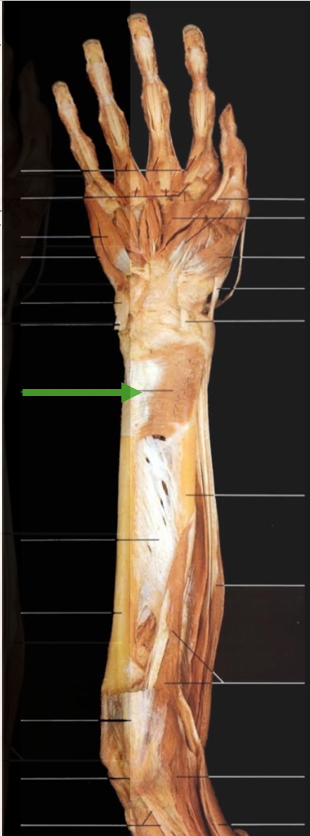
Identify
Pronator Quadratus
Origin: Distal anterior ULNA
Insertion: Distal anterior RADIUS
Action: Pulls on radius causing pronation.
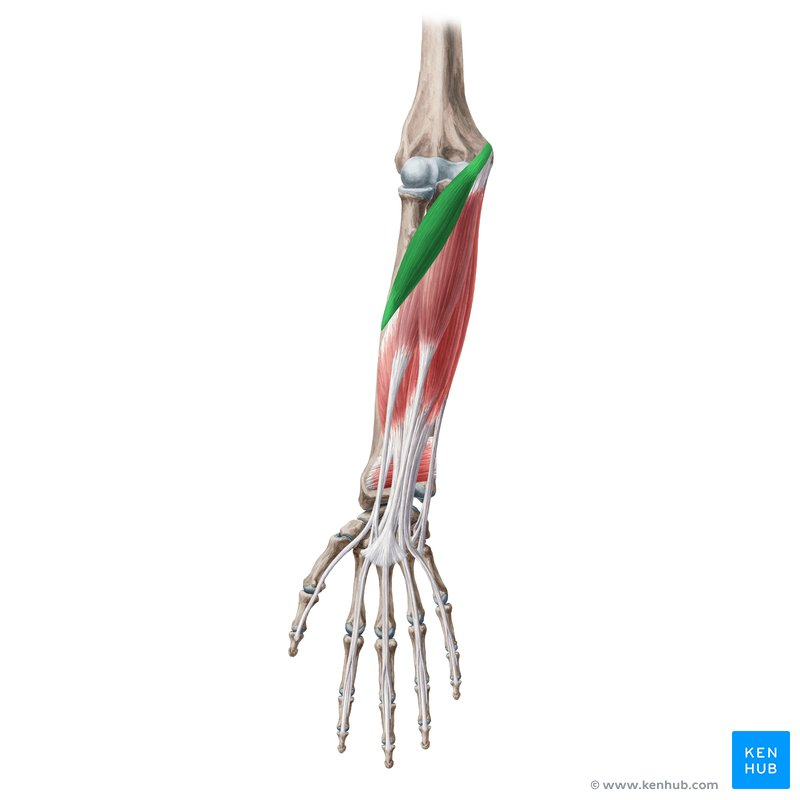
Pronator Teres
Origin: Medial epicondyle of humerus
Insertion: Lateral midshaft radius
Action: Pronation
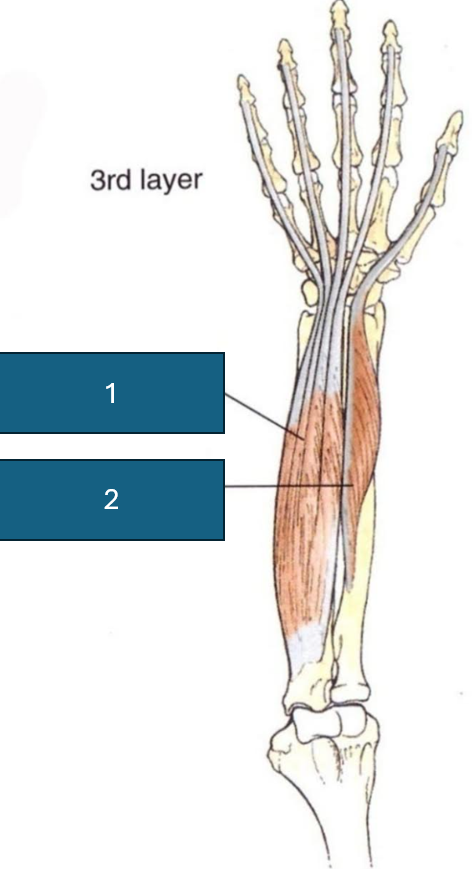
Identify 1
Flexor digitorum profundus
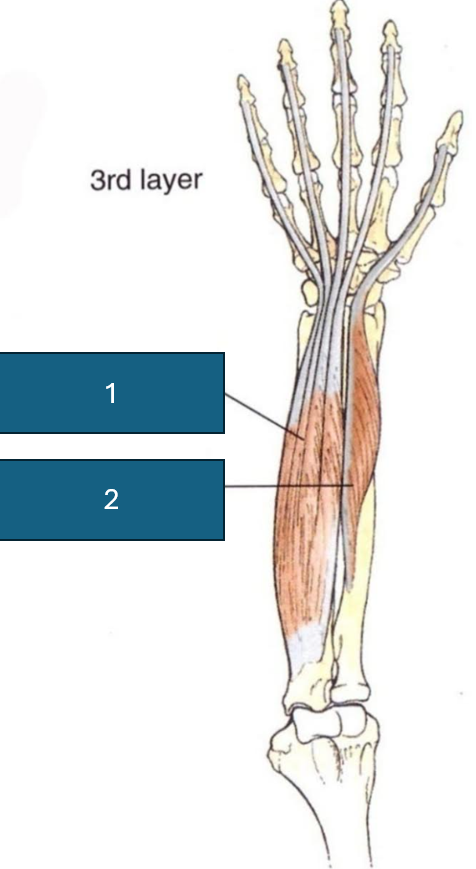
Identify 2
Flexor pollicis longus
Flexor carpi radialis
Origin: medial epicondyle of humerus
Insertion: Radial palmar hand
Action: Flexion and abduction of wrist.
Flexor carpi ulnaris
origin: medial epicondyle of humerus
insertion: ulnar palmar hand.
action: flexion and adduction of wrist
Palmaris longus
Origin: Medial epicondyle of humerus
Insertion: Palmar aponeurosis and flexor retinaculum
Action: Wrist flexion and tensing palmar aponeurosis
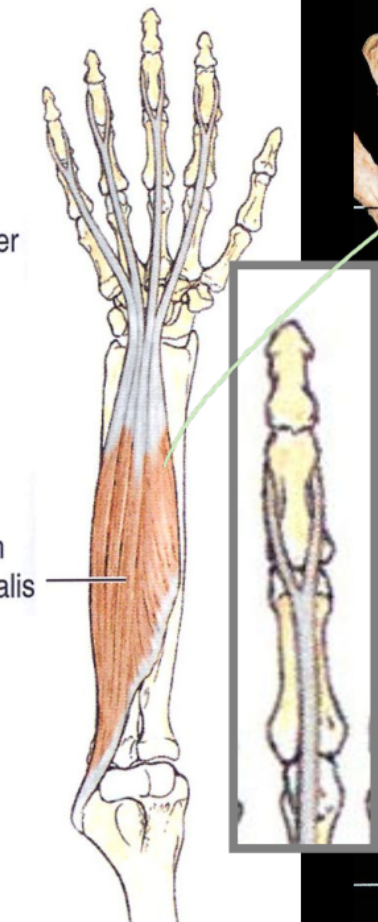
Flexor digitorum superficialis
Origin: Medial epicondyle of humerus
Insertion: Middle phalanges of digits 2-5
Action: Flex metacarpophalangeal joint and proximal interphalangeal joint.